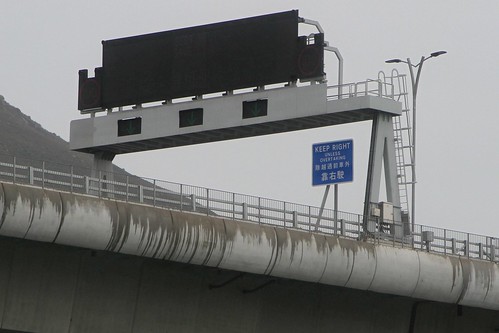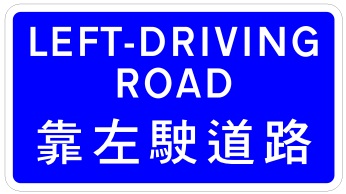Traffic in Hong Kong and Macau drive on the left, while vehicles in mainland China drive on the right – so what side does traffic on the Hong Kong-Zhuhai-Macao Bridge travel on?
The answer – on the right side, just like mainland China.
But the road signs on the Hong Kong side of the bridge are just the rest of the city – English and traditional Chinese text, but with ‘left’ and ‘right’ switched around.
The transition to mainland China-style road signs with simplified Chinese text occurring at the border itself.
But where does the traffic swap sides?
Swapping left and right
In 2009 an International Design Ideas Competition was launched for architecture, engineering, landscape architecture, planning and surveying professionals, seeking ideas for the final detailed design of the Hong Kong-Zhuhai-Macao Bridge. One of the more interesting ideas was the ‘Flipper’ bridge proposal submitted by NL Architects.
With the Hong Kong-bound right-hand driving carriageway ducking beneath the Mainland-bound bridge at the border, and emerging as left-hand driving.
But from a traffic flow perspective, a swap from left- to right-hand driving at the Hong Kong – China border is actually incredibly disruptive.

Legislative Council paper CB(4)653/16-17(01)
As the fast and slow lanes crossed over.
The Main Bridge, located in Mainland waters, will adopt the Mainland’s right-driving arrangement which is different from the left-driving arrangement of Hong Kong.
The connection point of the Main Bridge and the Hong Kong Link Road (HKLR) is an expressway with a speed limit of 100 km per hour. If the left-driving arrangement is changed to right-driving arrangement at the connection point, this would mean that vehicles (mainly medium and heavy vehicles) using the left-most lane (i.e. commonly known as “slow lane”) on the HKLR would need to switch to the right-most lane of the Main Bridge, or vehicles using the right-most lane (i.e. commonly known as “fast lane”) of the HKLR would need to switch to the left-most lane of the Main Bridge. In other words, vehicles would need to change lanes while moving at high speed and hence posing road safety problem.
So the final design placed the transition location at the border crossing facility in Hong Kong.
To reduce the need for changing lanes and to ensure road safety, the HKLR that connects with the Main Bridge (including the Scenic Hill Tunnel) will adopt the right-driving arrangement. There will be suitable road facilities to the north of the vehicle clearance plaza at the Hong Kong Boundary Crossing Facilities (HKBCF) to ensure safe interface of the left-driving arrangement and the right-driving arrangement.
Located on an artificial island off Lantau Island.
Where a tangle of flyover ramps was provided to separate the conflicting movements.
Along with signage indicating which side of the road to drive on.
Legislative changes
Changes to Hong Kong’s road rules were also required make driving on the right legal.
Pursuant to existing legislation relating to government tunnels, all buses, vehicles carrying dangerous goods, vehicles required to obtain a permit, as well as medium and heavy vehicles have to use the left-most lane of a government tunnel. We will add and amend existing provisions specifying that such vehicles in a right-driving government tunnel can only use the right-most lane.
Existing legislation related to traffic regulation contains references to “right turn”, “left side of a continuous white line with a broken line” and “left edge of a carriageway” in relation to box junction, double white line and road stud. We will add and amend existing provisions and revise the references to “left” and “right” so as to set out the requirements on box junction, double white line and road stud for right-driving roads.
Currently, vehicles on expressways are subject to restrictions on traffic directions, lanes that should be used by vehicles, lanes that can be used for overtaking, and the types of vehicles being prohibited from using the right-most lane. We will add and amend the existing provisions of the Road Traffic (Expressway) Regulations (Cap. 374Q) to revise the references to “left” and “right” so as to set out the requirements on traffic directions, lanes that should be used by vehicles, lanes that can be used for overtaking, and the types of vehicles being prohibited from using the left-most lane for right-driving expressways.
Footnote: plenty of objections
Turns out there were a number of objections from members of the Legislative Council regarding the introduction of right hand driving into Hong Kong.
Given that Hong Kong Link Road (HKLR) would be in Hong Kong waters, members queried about the rationales for adopting the right-driving arrangement on HKLR. Members expressed concern that this arrangement would cause inconvenience to Hong Kong drivers, who might also inadvertently fall foul of the law under this arrangement.
Some asking why a bridge linking two left hand drive countries should operate as right hand drive.
Mr Kwong Chun-yu pointed out that as both Hong Kong and Macao adopted the left-driving arrangement, drivers travelling between Hong Kong and Macao across the Main Bridge would need to change from the left-driving arrangement to right-driving arrangement on the Main Bridge, and then change back to the left-driving arrangement in Hong Kong/Macao.
Mr Kwong and other members including Mr Andrew Wan, Dr Cheng Chung-tai, Mr Jeremy Tam and Mr Nathan Law queried why left-driving arrangement was not adopted on the Main Bridge to bring convenience to drivers of Hong Kong and Macao. They enquired whether the Hong Kong Special Administrative Region (“SAR”) Government had ever explored with the Mainland authorities on the option of adopting left-driving arrangement on the Main Bridge.
Mr Jeremy Tam and Mr Nathan Law further suggested that if the left-driving arrangement was to be adopted on the Main Bridge, the switching between left-driving and right-driving arrangements could take place at the Zhuhai Boundary Crossing Facilities.
Specially given existing cross-border bridges from Hong Kong to China were left hand drive.
Miss Tanya Chan has pointed out that of the existing land-based boundary control points between Hong Kong and Guangdong, left-driving arrangement is adopted on the bridges straddling across Sha Tau Kok River and Shenzhen River at the Sha Tau Kok, Man Kam To and Lok Ma Chau boundary control points. The left-driving arrangement is also adopted along the Shenzhen Bay Bridge (“SBB”).
And that part of the bridge was located on Hong Kong territory.
The Deputy Chairman Dr Hon Kwok Ka-ki expressed grave concern about the adoption of the right-driving arrangement on HKLR, which in his view would undermine the principle of “One country, two systems”, given that HKLR was located in Hong Kong waters.
He was disappointed that the Administration had not revealed this proposal when it sought funding approval in respect of HZMB and related local projects from the Legislative Council (“LegCo”) in the past, and he was unconvinced by the Administration’s explanation about the technical constraints on the switching of driving arrangements at the boundary between the Mainland and Hong Kong.
Ms Claudia Mo further asked if the technical constraints on the switching of driving arrangements at the boundary were due to a design fault of HZMB or a lack of careful consideration at the design stage.
The Under Secretary for Transport and Housing explained that as it was located in the Mainland waters and was within the Mainland jurisdiction, right-driving arrangement was adopted under the territoriality principle.
With examples given of similar arrangements in other countries.
Members have also noted that the interface of left-driving and right-driving arrangements at boundary control points but not at the boundary connection point is not without precedent.
The Administration has given the examples of the Thai-Lao Friendship Bridge and the Second Thai-Lao Friendship Bridge as illustration.
Road facilities for switching between the left-driving and right-driving arrangements are located in the vicinity of the boundary crossing facilities in Lao and Thailand respectively, and there is no switching facility at the boundary connection point on the two bridges.
But the objections didn’t go anywhere – “Road Traffic (Expressway) (Amendment) Regulation 2017 (L.N. 64)” came into operation on 15 December 2017, and the bridge opened to right hand drive traffic on 24 October 2018.












Pingback: Hong Kong buses with doors on both sides - Checkerboard Hill
Pingback: Macau's exclave in Mainland China - Checkerboard Hill
Pingback: Swapping left and right on the Tuen Ma Line - Checkerboard Hill